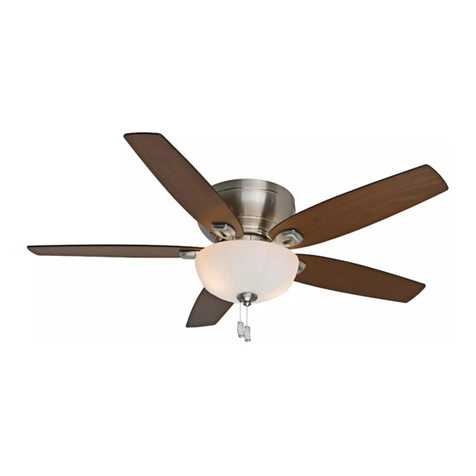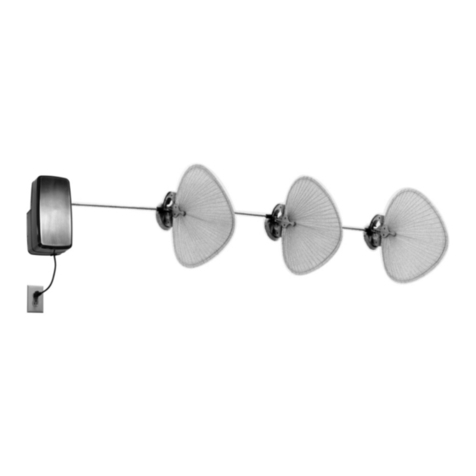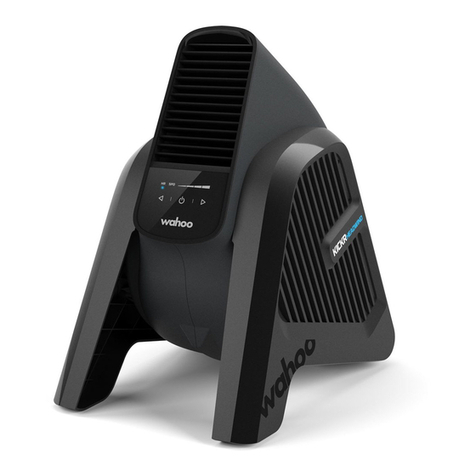Northern Meditec Crius V6 User manual

Crius V6/V8 Ventilator
Operator’s Manual
Northern Meditec Limited

2/182
© 2015-2017 ShenZhen Northern Meditec Limited. All rights Reserved.
For this Operator’s Manual, the issue date is Aug,2022.
Operator’s Manual Document No./Version: NR-TP-3162-001/A3.0
Software version: V01.01.07

3/182
Intellectual Property Statement
The user manual and the corresponding products of intellectual property belongs to Shenzhen
Northern Meditec Limited. (hereinafter referred to as "Northern").
The User’s Manual contains exclusive data under the protection of law of copyright. All rights
reserved. Any individual or organization must not reproduce, amend or translate the any part of the
User’s Manual without prior written approval from our company.
However, Northern does not take any responsibilities by the error of User Manual or the actual
performance resulting from incidental or consequential damages cause by the user manual.
Northern promise not to offer concessions to other parties conferred by patent law. Legal
consequences for violation of patent law and the rights of any third party caused, Northern does not
take legal responsibility

4/182
Responsibility on the Manufacturer Party
Contents of this manual are subject to change without prior notice.
All information contained in this manual is believed to be correct. Northern shall not be liable for errors
contained herein or for incidental or consequential damages in connection with the furnishing,
performance, or use of this manual.
Northern is responsible for the effects on safety, reliability and performance of this product, only if:
All installation operations, expansions, changes, modifications and repairs of this product are
conducted by Northern authorized personnel;
The electrical installation of the relevant room complies with the applicable national and local
requirements; and
The product is used in accordance with the instructions for use.
WARNING
It is important for the hospital or organization that employs this equipment to carry out a reasonable
service/maintenance plan. Neglect of this may result in machine breakdown or personal injury.
NOTE
This equipment must be operated by skilled/trained clinical professionals.
\

5/182
Warranty
THIS WARRANTY IS EXCLUSIVE AND IS IN LIEU OF ALL OTHER WARRANTIES, EXPRESSED
OR IMPLIED, INCLUDING WARRANTIES OF MERCHANTABILITY OR FITNESS FOR ANY
PARTICULAR PURPOSE.
In accordance with the conditions of storage and use, from the date of the factory 18 months, the
ventilator can not work properly, the company free of charge for the user repair, replacement parts
or products.
The design life of the ventilator is 10 years (batteries, folding bags and air bags and other
accessories are not included).
Exemptions
Northern's obligation or liability under this warranty does not include any transportation or other
charges or liability for direct, indirect or consequential damages or delay resulting from the improper
use or application of the product or the use of parts or accessories not approved by Northern or
repairs by people other than Northern authorized personnel.
This warranty shall not extend to:
Malfunction or damage caused by improper use or man-made failure.
Malfunction or damage caused by unstable or out-of-range power input.
Malfunction or damage caused by force majeure such as fire and earthquake.
Malfunction or damage caused by improper operation or repair by unqualified or unauthorized
service people.
Malfunction of the instrument or part whose serial number is not legible enough.
Others not caused by instrument or part itself.

6/182
Customer Service Department
Manufacturer: Northern Meditec Limited
Address: Room 501, 502 Building A, Room 401 Building C, JinWeiYuan Industrial
Area, No.41 Qingsong Road, Zhukeng Community, Longtian Sub-district,
Pingshan District, 518118 Shenzhen City, P.R. China
Website: www.northernmeditec.com
E-mail Address: info@northernmeditec.com
Tel: +86 755 27952733
Fax: +86 755 86528647
CE mark
EC-Representative: Umedwings Netherlands B.V.
Address: Treubstraat 1, 2288 EG Rijswijk,,the Netherlands
Website: www.umedwings.eu
E-mail Address: ar@umedwings.eu
Tel: +31(0)642758955

7/182
Preface
Manual Purpose
This manual contains the instructions necessary to operate the product safely and in accordance
with its function and intended use. Observance of this manual is a prerequisite for proper product
performance and correct operation and ensures patient and operator safety.
This manual is based on the maximum configuration and therefore some contents may not apply to
your product. If you have any question, please contact us.
This manual is an integral part of the product. It should always be kept close to the equipment so
that it can be obtained conveniently when needed.
Intended Audience
This manual is geared for clinical professionals who are expected to have a working knowledge of
medical procedures, practices and terminology as required for monitoring of critically ill patients.
Illustrations
All illustrations in this manual serve as examples only. They may not necessarily reflect the setup or
data displayed on your ventilator.
Conventions
Italic text is used in this manual to quote the referenced chapters or sections.
[ ] is used to enclose screen texts.
→ is used to indicate operational procedures.
Password
A password is required to access different menus within the ventilator.
Factory Setting: Contact customer service engineer
Alarm Vol:8888

8/182
Table of Contents
Chapter 1 Safety ...........................................................................................................................................14
1.1 Safety Information .................................................................................................................................... 14
1.1.1 Dangers........................................................................................................................................ 14
1.1.2 Warnings...................................................................................................................................... 14
1.1.3 Cautions....................................................................................................................................... 17
1.1.4 Notes .............................................................................................................................................18
1.2 Equipment Symbols .................................................................................................................................19
1.3 Symbols and Abbreviations....................................................................................................................20
1.3.1 Unit ................................................................................................................................................ 21
1.3.2 Symbols........................................................................................................................................21
1.3.3 Abbreviations ...............................................................................................................................22
Chapter 2 The Basics ..................................................................................................................................25
2.1. System Description ................................................................................................................................25
2.1.1 Work principle ..............................................................................................................................25
2.1.2 Intended Use............................................................................................................................... 27
2.1.3 Indications for use and contraindications............................................................................... 27
2.1.4 Target patient .............................................................................................................................. 27
2.1.5 Environment of use.....................................................................................................................27
2.1.6 Side-effect .................................................................................................................................... 28
2.1.7 Components ................................................................................................................................ 29
2.1.8 Clinical benifit .............................................................................................................................. 29
2.1.9 Intended user...............................................................................................................................29
2.2. Equipment Appearance.........................................................................................................................31
2.2.1 Front View ................................................................................................................................... 31
2.2.2 Rear View....................................................................................................................................33
Chapter 3 Installations and Connections ............................................................................................. 35
3.1 Install the Main Unit................................................................................................................................. 35
3.2 Connect to the Power Supply................................................................................................................ 37
3.2.1 Connect to AC Power .................................................................................................................37
3.3 Connect to the Gas Supply .................................................................................................................... 38
3.4 Install the Support Arm ............................................................................................................................39
3.5 Install the Patient Tubing........................................................................................................................ 41
3.5.1 Install Adult/Pediatric Tubing................................................................................................. 41
3.5.2 Install Neonate Tubing............................................................................................................43
3.6 Install the Humidifier ................................................................................................................................ 45
3.6.1 Install the Humidifier onto the Ventilator .................................................................................45
3.7 Install the O2Sensor ................................................................................................................................47

9/182
Chapter 4 User Interface ............................................................................................................................ 48
4.1 Display Controls ....................................................................................................................................... 48
4.2 System Check Screen.............................................................................................................................49
4.3 StandBy Screen....................................................................................................................................... 50
4.4 User Screen .............................................................................................................................................. 51
4.5 Measured Values Screen....................................................................................................................... 52
4.6 History Data .............................................................................................................................................. 53
4.6.1 Tabular Trend.............................................................................................................................. 53
4.6.2 Graphic Trend..............................................................................................................................55
4.6.3 Event Log..................................................................................................................................... 56
4.7 Big Font Screen........................................................................................................................................57
4.8 Big Loop Screen .......................................................................................................................................58
4.9 Freeze........................................................................................................................................................ 58
4.9.1 Enter freeze status .................................................................................................................... 59
4.9.2 Exit freeze status ....................................................................................................................... 59
4.10 Lock Screen ............................................................................................................................................ 59
Chapter 5 System Settings ....................................................................................................................... 60
5.1 Display Settings ........................................................................................................................................60
5.1.1 Interface........................................................................................................................................60
5.1.2 Waveforms...................................................................................................................................60
5.2 Set Unit...................................................................................................................................................... 60
5.2.1 Set Pressure Unit.......................................................................................................................60
5.2.2 Set Paw Unit ............................................................................................................................... 60
5.3 IBW/Height................................................................................................................................................ 61
5.4 Adjust Screen Brightness ........................................................................................................................61
5.5 Set Date and Time...................................................................................................................................61
5.6 Adjust Alarm Volume ...............................................................................................................................61
5.7 Adjust Alarm delay ...................................................................................................................................61
5.8 Screen Calibration ................................................................................................................................... 62
5.9 Defaults......................................................................................................................................................62
5.10 Set Language ......................................................................................................................................... 62
5.11 Set 100%O2Active Time...................................................................................................................... 62
5.12 Set Protect Board Switch ......................................................................................................................62
5.13 Set Mexico Logo Switch........................................................................................................................63
5.14 Module setup .......................................................................................................................................... 63
5.14.1 Set CO2module ....................................................................................................................... 63
5.15 Set CO2Mode .........................................................................................................................................63
5.15.1 Setting the working status......................................................................................................63
5.15.2 Set CO2Units ........................................................................................................................... 63
5.15.3 Set O2compensation .............................................................................................................. 63
5.15.4 Set CO2suffocation.................................................................................................................64
5.16 Select mode Calibration ........................................................................................................................64
5.17 Set Mode Parameter............................................................................................................................. 64
5.17.1 Set PEEP ................................................................................................................................... 64

10 /182
5.17.2 Set Vt .......................................................................................................................................... 64
5.17.3 Set Psupp ...................................................................................................................................64
5.17.4 Set Pinsp .................................................................................................................................... 65
5.17.5 Set Tinsp .................................................................................................................................... 65
5.17.6 Set Rate ......................................................................................................................................65
5.17.7 Set Trigger ................................................................................................................................. 66
5.17.8 Set Tslope .................................................................................................................................. 66
5.17.9 Set Phigh ....................................................................................................................................66
5.17.10 Set Plow................................................................................................................................... 67
5.17.11 Set Thigh.................................................................................................................................. 67
5.17.12 Set Tlow....................................................................................................................................67
5.17.13 Set O2 concentration ............................................................................................................. 67
5.17.14 Set Flow....................................................................................................................................68
5.17.15 Set Pmax..................................................................................................................................68
5.18 Manage Default Settings ...................................................................................................................... 68
5.18.1 Restore Factory Default Settings ........................................................................................... 69
5.19 View System Information ......................................................................................................................69
5.19.1 Version Information .................................................................................................................. 69
5.19.2 Configuration Information........................................................................................................ 69
5.19.3 Maintenance Information.........................................................................................................69
Chapter 6 Ventilation .................................................................................................................................. 70
6.1 Turn on the System ..................................................................................................................................70
6.2 System Check ...........................................................................................................................................70
6.3 Select Patient............................................................................................................................................72
6.4 Ventilation Type ........................................................................................................................................72
6.4.1 Invasive Ventilation .....................................................................................................................72
6.4.2 Non-invasive Ventilation (NIV) ..................................................................................................73
6.4.3 Set Ventilation Type................................................................................................................... 73
6.5 Ventilation Mode .......................................................................................................................................73
6.5.1 Ventilation Mode and Parameter Setup ..................................................................................74
6.5.2 IPPV .............................................................................................................................................. 75
6.5.3 SIMV, SIMV/ASB ........................................................................................................................ 76
6.5.4 BIPAP,BIPAP/ASB ..................................................................................................................... 78
6.5.5 BiPAP/assist ................................................................................................................................ 80
6.5.6 CPAP,CPAP/ASB....................................................................................................................... 81
6.5.7 MMV,MMV/ASB .......................................................................................................................... 82
6.5.8 APRV ............................................................................................................................................ 83
6.6 Set Alarm Limits....................................................................................................................................... 84
6.7 Start Ventilation ........................................................................................................................................ 84
6.8 Ventilation Parameters............................................................................................................................84
6.9 Enter Standby Status.............................................................................................................................. 87
6.10 Turn the System off............................................................................................................................... 87
Chapter 7 CO2Monitoring ........................................................................................................................ 88

11 /182
7.1 Summary ................................................................................................................................................... 88
7.2 Monitoring ways ....................................................................................................................................... 88
7.2.1 Main stream ................................................................................................................................. 88
7.2.2 Side stream..................................................................................................................................90
7.2.3 Set CO2........................................................................................................................................91
7.3 Mainstream CO2 module........................................................................................................................91
7.3.1 Installation.................................................................................................................................... 91
7.3.2 Checking before using ............................................................................................................... 93
7.3.3 Affecting factors of monitoring ..................................................................................................93
7.3.4 Monitor calibration ...................................................................................................................... 93
7.3.5 Module LED status information ................................................................................................ 94
7.3.6 Module cleanliness ..................................................................................................................... 95
7.4 Sidestream CO2module......................................................................................................................... 95
7.4.1 Installation.................................................................................................................................... 95
7.4.2 Checking before using ............................................................................................................... 96
7.4.3 Affecting factors of monitoring ..................................................................................................96
7.4.4 Module calibration .......................................................................................................................97
7.4.5 Module LED status information ................................................................................................ 98
7.4.6 Module cleanliness ..................................................................................................................... 98
7.5 Compensation ...........................................................................................................................................98
7.6 About Masimo ...........................................................................................................................................99
Chapter 9 Special Functions .................................................................................................................. 100
9.1 Manual Breath.........................................................................................................................................100
9.2 Expiration Hold ....................................................................................................................................... 100
9.3 Inspiration Hold .......................................................................................................................................100
9.4 100%O2 (O2 enrichment).....................................................................................................................101
9.5 P0.1.......................................................................................................................................................... 101
9.6 O2Therapy.............................................................................................................................................. 102
9.7.1 Switching on O2 Therapy........................................................................................................ 102
9.7.2 O2 Therapy Timer ....................................................................................................................103
9.7.3 Switching off O2Therapy .......................................................................................................103
Chapter 10 Alarms ..................................................................................................................................... 105
10.1 Summary ............................................................................................................................................... 105
10.1.1 Alarm type ................................................................................................................................ 105
10.1.2 Alarm level ............................................................................................................................... 106
10.2 Alarm mode ...........................................................................................................................................106
10.2.1 Light alarm ............................................................................................................................... 106
10.2.2 Audible alarm...........................................................................................................................107
10.2.3 Alarm information ....................................................................................................................107
10.2.4 Parameters scintillation ..........................................................................................................108
10.2.5 Alarm Audio Pause .................................................................................................................108
10.2.6 Cancellation of Alarm Audio Pause ..................................................................................... 108
10.3 Flashing Alarm Numeric ......................................................................................................................108

12 /182
10.4 Set Alarm Volume................................................................................................................................ 108
10.5 Set Alarm Limits ................................................................................................................................... 109
10.6 Alarm Tests ........................................................................................................................................... 109
10.6.1 Loss of Power ..........................................................................................................................109
10.6.2 Paw Too High .......................................................................................................................... 109
10.6.3 Paw Too Low ...........................................................................................................................110
10.6.4 VTi Too High ............................................................................................................................110
10.6.5 MVe Too High..........................................................................................................................110
10.6.6 MVe Too Low.......................................................................................................................... 110
10.6.7 O2 Supply Failure ................................................................................................................... 110
10.6.8 PEEP Too High....................................................................................................................... 110
10.6.9 PEEP Too Low........................................................................................................................ 111
10.6.10 Rtotal Too High..................................................................................................................... 111
10.6.11 Airway Obstructed ................................................................................................................ 111
10.6.12 FiO2 Too High....................................................................................................................... 111
10.6.13 FiO2 Too Low........................................................................................................................ 111
10.6.14 EtCO2 Too High ....................................................................................................................112
10.6.15 EtCO2 Too Low .....................................................................................................................112
10.6.16 FiCO2 Too High.................................................................................................................... 112
10.6.17 awRR Too High.....................................................................................................................112
10.6.18 awRR Too Low......................................................................................................................113
10.7 When an Alarm Occurs .......................................................................................................................113
10.8 Alarm information table ....................................................................................................................... 114
10.8.1 Physiological alarm.................................................................................................................114
10.8.2 Technical alarm .......................................................................................................................116
Chapter 11 Cleaning and Disinfection ................................................................................................. 120
11.1 Methods for Cleaning and Disinfection ............................................................................................ 121
11.2 Cleaning,disinfection ........................................................................................................................... 123
11.2.1 Expiration Valve Assembly....................................................................................................123
11.2.2 Inspiration Safety Valve Assembly ...................................................................................... 125
11.2.3 High Efficiency Particle Air (HEPA) Filter Assembly and Dust Filter ............................. 127
11.2.4 Patient Tubing ......................................................................................................................... 128
11.2.5 Humidifier ................................................................................................................................. 130
11.2.6 Mainstream CO2 Sensor .......................................................................................................131
Chapter 12 Maintenance .......................................................................................................................... 132
12.1 Repair Policy .........................................................................................................................................132
12.2 Maintenance Schedule ........................................................................................................................132
12.3 Essential performance ........................................................................................................................ 134
12.4 Pressure and Flow Zeroing ................................................................................................................ 135
12.5 Flow Calibration ....................................................................................................................................136
12.6 Oxygen Concentration Calibration .................................................................................................... 136
12.7 CO2Calibration .....................................................................................................................................137
12.8 Touch Screen Calibration ................................................................................................................... 138

13 /182
12.9 Battery Maintenance ............................................................................................................................138
12.9.1 Battery Performance Conditioning .......................................................................................139
12.9.2 Battery Performance Checking ............................................................................................ 140
12.9.3 Battery Storage....................................................................................................................... 141
12.9.4 Battery Recycling....................................................................................................................141
12.9.5 Disposing ..................................................................................................................................141
12.10 Electrical Safety Inspection .............................................................................................................. 142
12.11 Water Build-up in the Flow Sensor ................................................................................................. 143
12.11.1 Prevent Water Build-up ...................................................................................................... 143
12.11.2 Clear Water Build-up .......................................................................................................... 144
Chapter 13 Accessories ...........................................................................................................................145
Recommended device combined with ventilator to use ................................................................ 146
Chapter 14 Theory of Operation ............................................................................................................ 147
14.1 Pneumatic System ...............................................................................................................................147
14.1.1 Pneumatic Circuit Diagram................................................................................................... 147
14.1.2 Parts List ...................................................................................................................................147
14.1.3 Theory .......................................................................................................................................148
Chapter 15 Product Specifications .......................................................................................................151
15.1 Environmental Specifications.............................................................................................................151
15.2 Safety Specifications ........................................................................................................................... 151
15.3 Power Requirements...........................................................................................................................152
15.4 Physical Specifications........................................................................................................................153
15.5 Pneumatic System Specifications .....................................................................................................154
15.6 Ventilator Specifications ..................................................................................................................... 156
15.7 Settable Alarms.................................................................................................................................... 159
15.8 Special Functions.................................................................................................................................160
15.9 CO2Module Specifications .................................................................................................................161
15.10 O2 Sensor Specifications ................................................................................................................. 172
15.11 Factory Defaults ................................................................................................................................. 173
15.11.1 CO2 Module......................................................................................................................... 173
5.11.2 Alarm default setting ............................................................................................................. 173
5.11.3 User setting .............................................................................................................................174
15.11.4 History Data..........................................................................................................................174
15.11.5 Therapy................................................................................................................................. 174
15.12 EMC and Radio Regulatory Compliance ....................................................................................... 174
15.14.1 EMC .......................................................................................................................................174
Appendix A Toxic or Harmful Substances or Elements ................................................................. 181

14 /182
Chapter 1 Safety
1.1 Safety Information
DANGER
Indicates an imminent hazard that, if not avoided, will result in death or serious injury.
WARNING
Indicates a potential hazard or unsafe practice that, if not avoided, could result in death or serious
injury.
CAUTION
Indicates a potential hazard or unsafe practice that, if not avoided, could result in minor personal injury
and/or product/property damage.
NOTE
Provides application tips or other useful information to ensure that you get the most from your product.
1.1.1 Dangers
There are no dangers that refer to the product in general. Specific “Danger” statementsmay be
given in the respective sections of this manual.
1.1.2 Warnings
WARNING
The ventilator must only be operated and used by authorized medical personnel well trained in the
use of this product. It must be operated strictly following the Operator’s Manual.
Before putting the system into operation, the operator must verify that the equipment, connecting
cables and accessories are in correct working order and operating condition.
To avoid the risk of electric shock, this equipment must be connected to a properly installed power
outlet with protective earth contacts only. If the installation does not provide for a protective earth

15 /182
conductor, disconnect it from the power line.
Use external power source (AC power or DC power) before the batteries are depleted.
To avoid explosion hazard, do not use the equipment in the presence of flammable anesthetic
agent, vapors or liquids. When O2 is used, keep the ventilator away from any fire sources.
Do not place the ventilator adjacent to any barrier, which can prevent cold air from flowing,
resulting in equipment over heat.
Do not open the equipment housings. All servicing and future upgrades must be carried out by the
personnel trained and authorized by us only.
Do not rely exclusively on the audible alarm system for patient monitoring. Adjustment of alarm
volume to a low level may result in a hazard to the patient. Remember that alarm settings should
be customized according to different patient situations and always keeping the patient under close
surveillance is the most reliable way for safe patient monitoring.
The physiological parameters and alarm messages displayed on the screen of the equipment are
for doctor’s reference only and cannot be directly used as the basis for clinical treatment.
To dispose of the package material, observe the applicable waste control regulations. And keep
the package material out of children’s reach.
All staff should be aware that disassembling or cleaning some parts of the ventilator can cause risk
of infection.
Maintenance menu can only be accessed when the equipment is disconnected from the patient.
Positive pressure ventilation may be accompanied by some side effects such as barotrauma,
hypoventilation, hyperventilation, etc.
Using the ventilator in the vicinity of high frequency electrosurgery equipment, defibrillators or
short-wave therapy equipment may impair correct functioning of the ventilator and endanger the
patient.
Do not use antistatic or conductive masks or patient tubing. They can cause burns if they are used
near high frequency electrosurgery equipment.
Do not use the ventilator in a hyperbaric chamber to avoid potential fire hazard due to an
oxygen-enriched environment.
If the equipment internal monitoring system malfunctions, an alternative plan must be available to
ensure adequate level of monitoring. The operator of the ventilator must be responsible for
patient’s proper ventilation and safety under all circumstances.
As required by the relevant rules and regulations, oxygen concentration should be monitored when
the equipment is used on the patient. If your ventilator is not configured with such monitoring
function or this function is turned off, use a monitor which complies with the requirements of ISO
80601-2-55 for oxygen concentration monitoring.
All analog or digital products connected to this system must be certified to the specified IEC
standards (such as IEC 60950 for data processing equipment and IEC 60601-1 for medical
electrical equipment). All configurations shall comply with the valid version of IEC 60601-1. The

16 /182
personnel who are responsible for connecting the optional equipment to the I/O signal port shall be
responsible for medical system configuration and system compliance with IEC 60601-1 as well.
Do not touch the patient when connecting the peripheral equipment via the I/O signal ports or
replacing the oxygen cell, to prevent patient leakage current from exceeding the requirements
specified by the standard.
This equipment is not suitable for use in an MRI environment.
When the ventilator’s gas supply input system fails or has faults, please contact us immediately for
service by specified personnel.
The ventilator shall not be used with helium or mixtures with Helium.
Do not move the ventilator before removing the support arm from it, in order to avoid the ventilator
getting tilted during the movement.
Do not block the air intake at the rear of the ventilator.
To prevent interrupted operation of the ventilator due to electromagnetic interference, avoid using
the ventilator adjacent to or stack with another device. If adjacent or stacked use is necessary,
verify the ventilator’s normal operation in the configuration in which it will be used.
To prevent possible personal injury and equipment damage, ensure that the ventilator is secured
to the trolley or placed on the safe and smooth surface.
To prevent possible equipment damage, avoid tipping over the ventilator when crossing
thresholds.
To prevent possible equipment damage, push the brake down when parking the ventilator.
Avoid the use of polluted air. When the equipment uses air as gas source for ventilation, if the air is
polluted, harmful substance may enter the patient tubing
To prevent patient injury caused by equipment malfunction, when the alarm [Technical Error**]
occurs, remove the equipment immediately, record failure code, and contact the Customer Service
Department.
To prevent possible ventilator malfunction, do not spill liquid onto the ventilator.
A turbine can cause gas to be heated. To reduce the temperature of gas inside the tubing and
prevent patient injury accordingly, ensure that the length of patient tubing from the humidifier to Y
piece is greater than 1.2m.
The internal electrical power source is to be used if the integrity of the protective earth conductor or
the protective grounding system in the installation is in doubt.
Nebulization or humidification can increase the resistance of breathing system filters, and that you
need to monitor the filter frequently for increased resistance and blockage.
The ventilation accuracy can be affected by the gas added by use of a nebulizer.
The ventilator shall not be used with nitric oxide.
For non-invasive ventilation, the exhaled volume of the patient can differ from the measured
exhaled volume due to leaks around the mask.
Check if the alarm limit settings are appropriate before taking measurement.

17 /182
When operating the unit with the power supply unit, always connect the unit to an easily accessible
outlet so that it can be unplugged quickly in the event of a malfunction.
No modification of this equipment is allowed.
Failure to have an alternative means of ventilation such as a self-inflating, manually-powered
resuscitator (as specified in ISO 10651-4) with mask can result in PATIENT death if the
VENTILATOR fails.
Stop using the ventilator and contact us immediately when the buzzer sounds.
Under the ambient temperature of 40℃, the inspiratory pressure of the ventilator exceeds 60
cmH2O, and the maximum temperature on the surface of breathing mask may exceed 41ºC but
does not exceed 43℃
The effect that a potential hazard can exist if different ALARM PRE-SETS are used for the same or
similar equipment in any single area.
1.1.3 Cautions
CAUTION
The ventilator must be inspected and serviced regularly by trained service personnel.
To ensure patient safety, always prepare resuscitator for use.
Always have a special person attend and monitor the operation of the equipment once the
ventilator is connected to the patient.
During the operation of the ventilator, do not disassemble the inspiration safety valve and
expiration valve unless in standby status.
To ensure patient safety, use only parts and accessories specified in this manual.
At the end of its service life, the equipment, as well as its accessories, must be disposed of in
compliance with the guidelines regulating the disposal of such products.
Magnetic and electrical fields are capable of interfering with the proper performance of the
equipment. For this reason, ensure that all external devices operated in the vicinity of the
equipment comply with the relevant EMC requirements. Mobile phone, X-ray equipment or MRI
devices are a possible source of interference as they may emit higher levels of electromagnetic
radiation.
This system operates correctly at the electrical interference levels identified in this manual. Higher
levels can cause nuisance alarms that may stop mechanical ventilation. Pay attention to false
alarms caused by high-intensity electrical fields.
CAUTION
Before connecting the equipment to the power line, check that the voltage and frequency ratings of

18 /182
the power line are the same as those indicated on the equipment’s label or specified in this manual.
Always install or carry the equipment properly to avoid damage caused by dropping down, impact,
strong vibration or other mechanical force.
To electrically isolate the ventilator circuits from all poles of the supply mains simultaneously,
disconnect the mains plug. Do not to position the ME EQUIPMENT so that it is difficult to operate the
disconnection device.
To minimize the risk of fire, do not use low-pressure gas tubes that are worn or contaminated with
combustible materials like grease or oil.
It is the clinician’s responsibility to ensure that all ventilator settings are appropriate.
To prevent possible patient injury, ensure the ventilator is set up for appropriate patient type with the
appropriate patient tubing. Ensure the System Check is performed before each patient.
Perform Flow Sensor Calibration before the first use, or when the measured values have deviations.
To prevent possible patient injury, ensure the ventilation parameters are set up properly before
ventilating the patient.
To ensure the accuracy of oxygen monitoring, replace an exhausted oxygen cell as soon as
possible or use an external monitor that complies with ISO 80601-2-55.
A fan failure could result in oxygen enrichment inside the ventilator and a subsequent fire hazard.
To reduce the risk of explosion, do not burn the O2 cell or force the cell open.
When ventilating with a mask, avoid high airway pressures. High pressures may cause gastric
distension.
Peak pressures, exceeding 33 cmH2O, may increase the risk of aspiration due to gastric
insufflation. When ventilating with such pressures, consider using an invasive mode.
To reduce the risk of fire, use only tube systems approved for medical purposes and for use with
oxygen between the oxygen source and ventilator.
To reduce the risk of fire, ensure adequate ventilation at the rear of the ventilator.
To reduce the risk of fire, switch off the oxygen source when the ventilator is not in a ventilating
mode.
Avoid putting the ventilator in the storage environment of more than 50℃for a long time. Such
environment may damage or shorten the battery lives of internal battery and oxygen sensor.
Use the original packing materials to ship the ventilator.
To prevent fire hazard, use only specified fuses or fuses with the same type, rated voltage, and
rated current as the existing fuses. When it is necessary to replace fuses, contact the Customer
Service Department.
The ventilator is suitable for use within the PATIENT ENVIRONMENT.
Additional MULTIPLE SOCKET- OUTLET or extension cord shall not be connected to the system.
Before moving the ventilator, ensure that the casters and brakes can work properly, and the main
unit is locked on the trolley.
1.1.4 Notes

19 /182
NOTE
Put the ventilator and its accessories in a location where you can easily see the screen and access
the operating controls.
Keep this manual close to the equipment so that it can be obtained conveniently when needed.
The software was developed in compliance with IEC 62304. The possibility of hazards arising from
software errors is minimized.
This manual describes all features and options. Your equipment may not have all of them.
When resumed from over 30s of an interruption of AC power supply, the ventilation devices ,
alarms and gas monitoring devices of the ventilator still work normally.
1.2 Equipment Symbols
Symbol
Meaning
Symbol
Meaning
Notice! Check the
documentation
Refer to user manual
Switch on/off key
Up selection operation key
Enter key
Down to select the operation key
Network connector
USB connector
Ventilator gas outlet
Flow sensor
Oxygen sensor connector
RS-232 connector
Expiration connector
Inspiration connector
AUDIO PAUSED
CO2module
Date of manufacture
Manufacturer
Serial number
IP21
Degree of protection provided by
enclosure
Protective earth ground
CE mark

20 /182
Symbol
Meaning
Symbol
Meaning
Type BF applied part.
Defibrillation-proof protection
against electric shock.
MR Unsafe - do not subject to
magnetic resonance imaging (MRI)
The EU Representative
Office
Stacking limit by number
Temperature limitation
Humidity limitation
Atmospheric pressure
limitation
This way up
Fragile, handle with care
Keep dry
Recyclable
Equipotential
The following definition of the WEEE label applies to EU member states only.
This symbol indicates that this product should not be treated as household waste. By
ensuring that this product is disposed of correctly, you will help prevent bringing potential
negative consequences to the environment and human health. For more detailed
information with regard to returning and recycling this product, please consult the
distributor from whom you purchased it.
* For system products, this label may be attached to the main unit only.
CAUTION
It is recommended to connect this equipment to equipotential system. Use yellow and green
equipotential grounding cables, one end is connected to position with symbol, and other end is
connected to equipotential system. Use of potential equalization conductor together with a
reference to requirements in clause 16 of IEC 60601-1 for Medical Electrical System.
1.3 Symbols and Abbreviations
Other manuals for Crius V6
1
This manual suits for next models
1
Table of contents
Popular Fan manuals by other brands

Harbor Breeze
Harbor Breeze E-WCK44ABZ5LKS manual
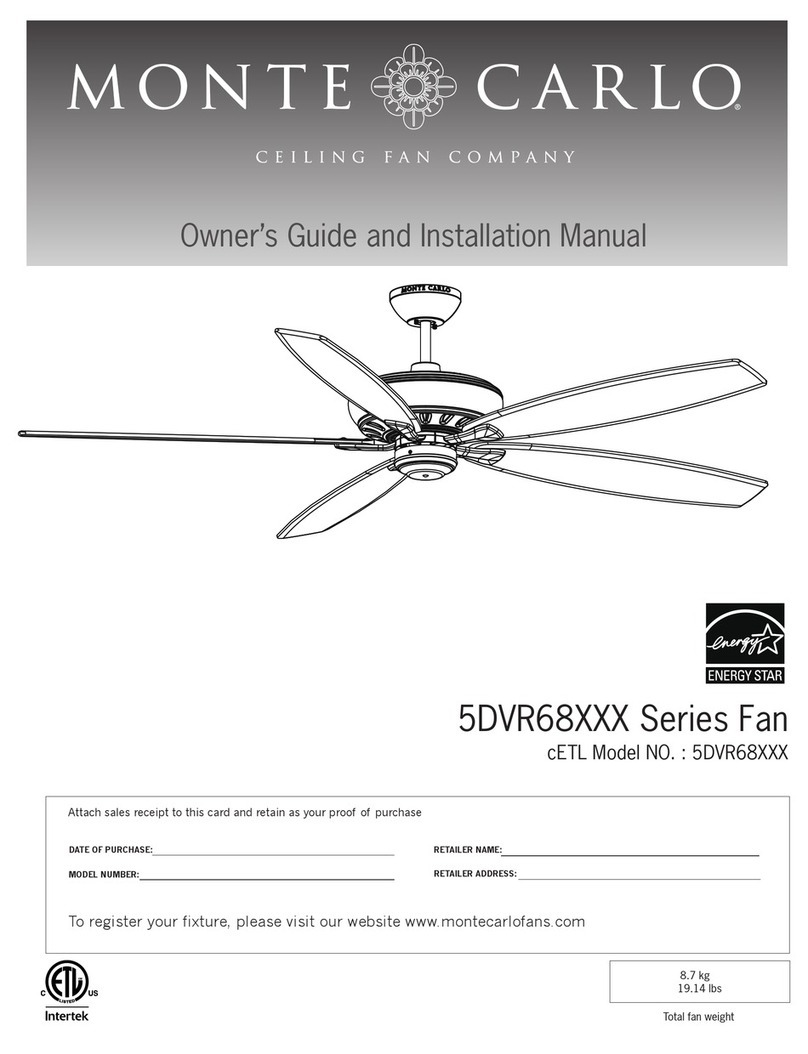
Monte Carlo Fan Company
Monte Carlo Fan Company 5DVR68 Series Owner's guide and installation manual
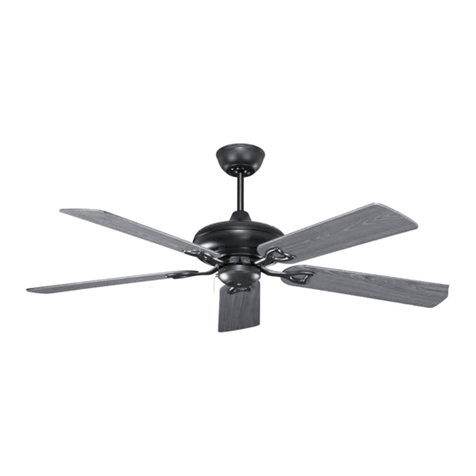
Mr.Ken
Mr.Ken Cassandra instruction manual

Modern Fan Co
Modern Fan Co Torsion installation instructions

Hunter
Hunter Postman installation manual
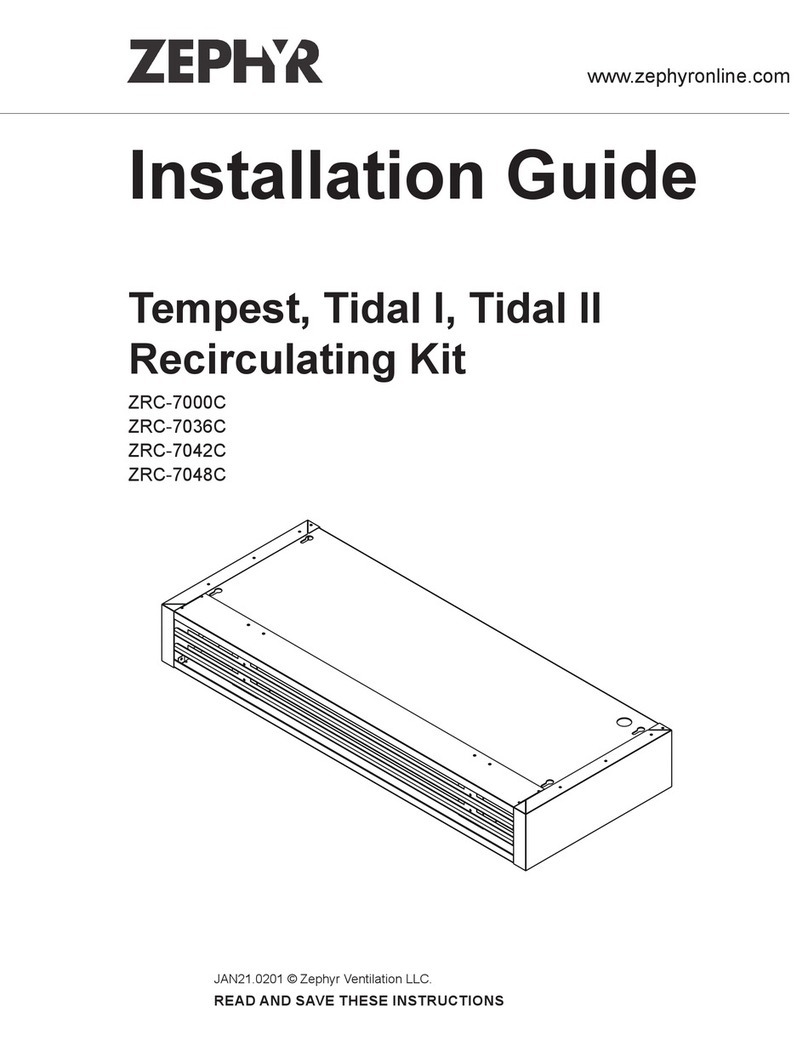
Zephyr
Zephyr ZRC-7036C installation guide



